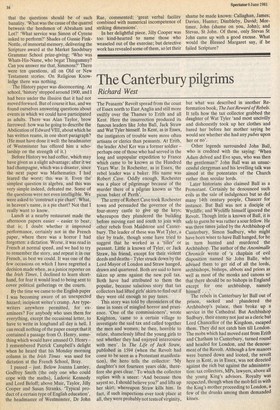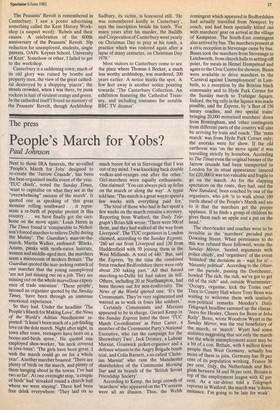The Canterbury pilgrims
Richard West
The Peasants' Revolt spread from the coast of Essex north to East Anglia and still more swiftly over the Thames to Erith and all Kent. Here the insurrection produced its famous leaders like John Ball, Jack Straw and Wat Tyler himself. In Kent, as in Essex, the instigators of trouble were more often artisans or clerics than peasants. At Erith, the leader Abel Ker was a former soldier â perhaps one of those who had served in the long and unpopular expedition to France which came to be known as the Hundred Years War. In Rochester, as in Essex, the rebel leader was a baker. His name was Robert ,Cave. Oddly enough, Rochester was a place of pilgrimage because of the murder there of a pilgrim known as 'the pious baker of Perth'.
The army of Robert Cave took Rochester town and persuaded the governor of the four-storey castle to give up the keys; whereupon they plundered the building before moving east and south to join with other rebels from Maidstone and Canterbury. The leader of these was Wat Tyler, a tiler by trade, though some have tried to suggest that he worked as a 'tiller' or peasant. Little is known of Tyler, or Jack Straw, his friend, except for their violent deeds and deathsâ Tyler struck down by the Lord Mayor of London and Straw hanged, drawn and quartered. Both are said to have taken up arms against the new poll tax. Both have had attributed to them the popular, because salacious story that tax collectors had lifted girls' skirts to find out if they were old enough to pay taxes.
This story was told by chroniclers of the time in tones of mingled horror and prurience. 'One of the commissioners', wrote Knighton, 'came to a certain village to investigate the said tax and called together the men and women; he then, horrible to relate, shamelessly lifted the young girls to test whether they had enjoyed intercourse with men'. In The Life of Jack Straw, published in 1594 (when the Revolt had come to be seen as a Protestant manifestation), the hero tells the collector: 'My daughter's not fourteen years olde, therefore she goes clear.' To which the collector replies with a sneer: 'And because thou sayest so, I should believe you?' and lifts up her skirt; whereupon Straw kills him. In fact, if such inspections ever took place at all, they were probably not tests of virginity, but what was described in another Reformation book, The Just Reward of Rebels. It tells how the tax collector grabbed the daughter of Wat Tyler 'and most uncivilly and dishonestly took up her clothes and bared her before her mother saying he would see whether she had any pubes upon her or no'.
Other legends surrounded John Ball, who is credited with the saying: 'When Adam delved and Eve span, who was then the gentleman?' John Ball was an unsuccessful clergyman and his levelling talk was aimed at the potentates of the Church rather than secular lords.
Later historians also claimed Ball as a Protestant. Certainly he denounced such evils as the sale of indulgences but so did many 14th century people, Chaucer for instance. But Ball was not a disciple of Wycliffe; and Wycliffe himself ignored the Revolt. Though little is known of Ball, it is safe to guess he was rather a sour fellow. He was three times jailed by the Archbishop of Canterbury, Simon Sudbury, who might have been wiser to have Ball hanged, for he in turn hunted and murdered the Archbishop. The author of the Anonimalle Chronicle wrote of 'a chaplain of evil disposition named Sir John Balle, who advised them to get rid of all the lords, archbishops, bishops, abbots and priors as well as most of the monks and canons so that there should be no bishops in England except for one archbishop, namely himself . .
The rebels in Canterbury let Ball out of prison, sacked and plundered the Archbishop's palace, then broke up a service in the Cathedral. But Archbishop Sudbury, their enemy not just as a cleric but Lord Chancellor of the Kingdom, escaped them. They did not catch him till London. The mobs which had moved east from Erith and Chatham to Canterbury, turned round and headed for London, and the denouement of the Revolt. Although a few manors were burned down and looted, the revolt here in Kent, as in Essex, was not directed against the rich but against the administration: tax collectors, MPs, lawyers, above all the young King's advisors. Royalty was respected, though when the mob fell in with the King's mother proceeding to London, a few of the drunks among them demanded kisses. The Peasants' Revolt is remembered in Canterbury. I saw a poster advertising something called the Kent History Workshop (a suspect word): 'Rebels and their causes. A celebration of the 600th anniversary of the Peasants' Revolt. 50p reduction for unemployed, students, single parents, OAPs. Keynes School, University of Kent'. Somehow or other, I failed to get to the workshop.
Canterbury is a saddening town; much of its old glory was ruined by bombs and property men, the view of the great cathedral destroyed by a shopping `piazza'; the streets crowded, when 1 was there, by punk rockers in hair of virulent orange and green. In the cathedral itself I found no memory of the Peasants' Revolt, though Archbishop Sudbury, its victim, is honoured still. 'He was remembered kindly in Canterbury', says the inscription beside his tomb. 'For many years after his murder, the Bailiffs and Corporation of Canterbury went yearly on Christmas Day to pray at his tomb, a practice which was restored again after a lapse of many centuries, on Christmas Day 1978.'
Most visitors to Canterbury come to see the place where Thomas a Becket, a much less worthy archbishop, was murdered, 200 years earlier. A notice marks the spot. A few feet away is another notice pointing towards: 'The Canterbury Collection. An exhibition featuring the Cathedral Treasury, and including costumes for notable BBC TV dramas'.











































 Previous page
Previous page